
by Judy Corbus | Jul 3, 2025
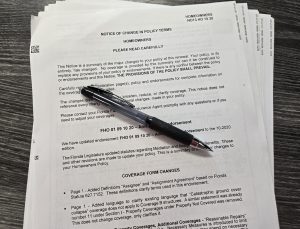
Check the terms of your homeowners or renters policy to make sure you have adequate coverage.
Photo credit: Judy Corbus, NW Extension District
Do you know what your home insurance covers? How about levels of coverage or exclusions? If you’re not sure, now is a good time to take a look at your homeowner’s or renter’s policy. Hurricane season potentially increases the likelihood of filing a claim and it’s wise to know your level of coverage, perils included (or excluded), and deductibles before the need arises.
How Much Insurance Should I Buy?
To be adequately covered, your home must be insured for the amount necessary to rebuild it at the current cost factoring in building material prices and labor costs. Also, depending on the age of your home, it may need to be repaired or rebuilt to meet current building codes. Law and Ordinance coverage will cover these additional costs so discuss your policy with your insurance agent. If your home is underinsured at the time of loss, there may be a penalty or reduction in the amount the insurance company will pay for the loss. Discuss both the limits and adequacy of types of coverage with your agent.
What Perils are Covered by My Policy?
Damage from rising water (flood) is not covered by most homeowners’ policies. You may purchase flood insurance through the National Flood Insurance Program (NFIP) or through private insurers. Flood insurance is available to cover your home and personal property. Usually, there is a 30-day waiting period before a flood insurance policy goes into effect with the NFIP, unless you purchase the policy at the same time you purchase or refinance your home. You may obtain flood insurance through your local agent.
You also should check for windstorm coverage, sinkholes and catastrophic ground cover collapse, and mold coverage.
Replacement Cost or Actual Cash Value?
These two settlement options are available when purchasing home insurance. Replacement Cost is the amount needed to repair or replace damaged property with materials of similar kind and quality without deducting for depreciation, which is the decrease in the value of your home or personal property due to normal wear and tear. Actual cash value is the amount needed to repair or replace an item, less depreciation. To receive replacement cost coverage, most homeowners’ insurance policies require the policyholder to insure the home for at least 80% of its replacement value.
What About the Hurricane Deductible?
The Hurricane Deductible is the deductible applied to loss caused by a hurricane. The deductible is the dollar amount paid by the policyholder before an insurance company pays anything. Typically, the hurricane deductible is $500 or two, five, or ten percent of the amount of insurance covering the dwelling at the time of loss. In Florida, you pay one hurricane deductible per calendar year as long as you are insured by the same insurer for the second or subsequent hurricanes for the same calendar year. The hurricane deductible applies from the time a hurricane watch or warning is issued for any part of Florida until 72 hours after the last hurricane watch or warning is terminated for any part of Florida.
Take a few moments to review your policy while the sun is shining and the waters are calm so you are prepared for hurricane season.
For more information on homeowners’ insurance, check out Homeowners Insurance A Toolkit for Consumers and Florida’s Hurricane Deductible.
Sources:
Homeowners Insurance A Toolkit for Consumers
Florida’s Hurricane Deductible
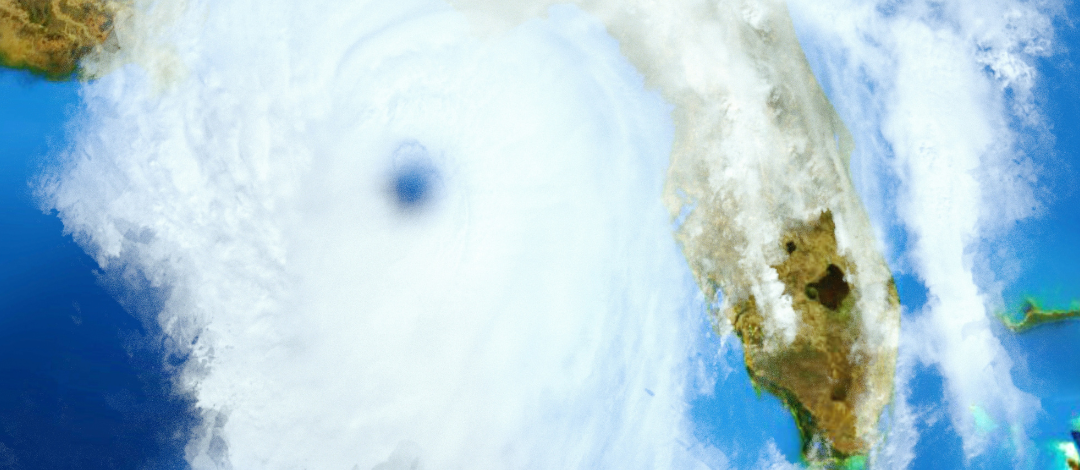
by Samantha Kennedy | Jun 30, 2025
As hurricane season approaches, families in coastal and low-lying areas are bracing themselves for the possibility of devastating storms. While many people may think they are prepared, the reality is that many families are not equipped with a plan to deal with the chaos and destruction that comes with a hurricane. In this article, we will explore the importance of developing a family emergency plan and provide tips on how to create a comprehensive plan that will keep your loved ones safe.
A Plan is Not a Guess
Developing a family emergency plan should not be a guessing game. It is a proactive step that can mean the difference between life and death. A plan outlines what to do in case of an emergency, including evacuation routes, safe meeting points, and communication protocols. Without a plan, families are left to fend for themselves, which can lead to confusion, panic, and tragedy.
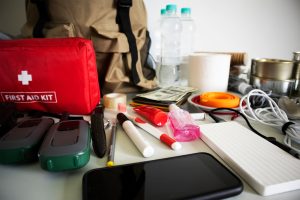
Now is the time to prepare your family’s emergency supply kit. Be sure to include items such as nutritious snacks, canned goods, important documents, first aid kit, and other essential items. (Adobe Stock photo)
Key Components of a Family Emergency Plan
A comprehensive family emergency plan should include the following key components:
Safe Meeting Point: Designate a safe meeting point outside the home in case you get separated. This could be a neighbor’s house, a landmark, or a specific location in your neighborhood.
Communication Plan: Establish a communication plan that includes how you will stay in touch with each other, including phone numbers, email addresses, and social media accounts.
Evacuation Routes: Identify evacuation routes and emergency shelters in your area. Make sure everyone knows the routes and shelters.
Emergency Contact Information: Make sure everyone knows important phone numbers, such as your insurance company, emergency services, and utility companies.
Important Documents: Keep important documents, such as insurance policies, identification, and medical records, in a safe and easily accessible location.
Tips for Creating a Family Emergency Plan
Involve Everyone: Make sure everyone in the household is involved in the planning process. This will ensure that everyone knows what to do in case of an emergency.
Practice Drills: Practice your emergency plan with regular drills to ensure everyone knows what to do.
Stay Informed: Stay informed about weather updates and emergency alerts from local authorities.
Review and Update: Review and update your emergency plan regularly to ensure it is current and effective.
Don’t Wait Until It’s Too Late
Do not wait until the last minute to develop a family emergency plan. The consequences of not having a plan can be dire. By creating a comprehensive plan, you will be better equipped to handle the challenges of hurricane season. Remember, a plan is not a guarantee of safety, but it can significantly reduce the risk of injury or death.
Safety Tips
- Stay away from windows and doors during a hurricane.
- Avoid traveling during a hurricane.
- Keep a first aid kit and emergency supplies with you at all times.
- Stay informed about the latest weather updates and forecasts.
- Follow evacuation orders from local authorities.
Developing a family emergency plan is a crucial step in ensuring the safety and well-being of your loved ones during hurricane season. By creating a comprehensive plan, you will be better equipped to handle the challenges of storms and reduce the risk of injury or death. Do not wait until it is too late – take action now and create a plan that will keep your family safe.
An Equal Opportunity Institution.

by Heidi Copeland | Jul 1, 2022
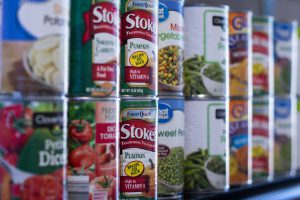
Stock up on canned fruits, vegetables, meats, and heat-and-eat soups for your hurricane food supply kit. Photo source: UF/IFAS Photo by Tyler Jones.
Even during hurricane season. Yes, the Atlantic hurricane season starts on June 1st and runs through November 30th every year. August and September are usually the busiest hurricane months in Florida. It is tempting to believe that danger will not be coming our way, however, the Sunshine State has already experienced Alex. Bonnie, Colin, Danielle… are sure to follow.
Planning for hurricane preparation takes time and money, however, planning can save you both time and money. Know, too, that your hurricane planning can accommodate other emergencies.
The Department of Homeland Security’s Build A Kit | Ready.gov suggests having enough provisions for two weeks in your basic emergency kit, whereas other sources state three days. Since Spring 2020, the Centers for Disease Control and Prevention (CDC) has recommended people include additional items in their kits to help prevent the spread of coronavirus or other viruses and the flu. (And don’t forget sanitation supplies and personal hygiene items. Poor hygiene can help spread disease, too).
A central step in planning for emergencies is to take advantage of what you have on hand and be mindful when adding to it. Taking an inventory of what you have is an important tool in managing personal resources. From your inventory, make a list of what you need to purchase. When shopping for nonperishable hurricane food items and supplies, use your list and stick to it. Adding a few items to each shopping trip can help spread the cost burden of stocking up on emergency supplies.
Being prepared means having your own food, water, and other related supplies (think home, yard, and even car). Now is also a good time to eat what is in your freezer (think power outages – frozen food has a time limit if your power goes out) and take stock of your pantry. It makes economic sense to plan to use what you have (think expiration dates – rotating pantry supplies), supplemented with nutritious, stocked hurricane supplies.
Additionally, one half of people in the United States take medication. Planning in advance for medical needs is as imperative as planning for food and other safety equipment.
Waiting until an announced, named storm hits the radar is often the wrong time to start your emergency preparation. Prices might be higher, and supplies might be harder to find. Plan and prepare now for whatever emergency may come your way. Personally, I went thirty years without needing anything but a flashlight on occasion to being without power for eight days during Hurricane Michael. Others in my area fared far worse.
Whether we want them or not, emergencies happen. Planning for one can save you both time and money.
Pantry Prep: Stock Up for Emergencies (English)
Pantry Prep: Stock Up for Emergencies (Spanish)
Prepare for Hurricane Season by Stocking up on Plenty of Non-Perishable Foods

by Judy Corbus | Aug 27, 2021
Next to ensuring your family’s safety and well-being during a hurricane, having a game plan to protect your largest investment – your home and property – is essential in preparing for a major storm or other disaster. Many of these tasks can be done as part of routine home maintenance well before a storm is on the horizon.
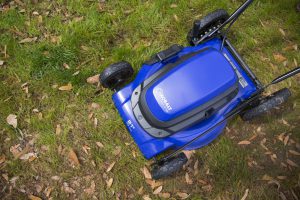
Mow your yard before a storm to make clean-up easier. Photo credit: UF/IFAS Photo by Camila Guillen
Let’s start with the outside:
- Trim back limbs and branches hanging over the roof and any dead limbs elsewhere in the yard. These can break off in high winds, causing roof and siding damage.
- Clean valleys, gutters, and downspouts of leaves and debris. This will improve water flow off the roof, reducing the risk of leaks.
- If a storm is approaching, move trash cans, lawn furniture, grills, decorative items, potted plants, and toys to the garage, shed, or other secure storage area. These items can become flying missiles in high winds!
- Protect windows with plywood or roll-down shutters. These protective barriers can:
- keep wind pressure from building up inside, leading to roof loss
- reduce the chance of glass breakage
- reduce the risk of wind-driven rain damaging your home’s interior
- Be sure to install plywood before wind speeds increase!
- Do NOT apply tape to windows. Tape will not protect against breakage from flying debris and wastes time and resources. Plus, the adhesive can be very difficult to remove from the glass.
- Protect the garage door with vertical bracing. You can install wooden columns or purchase a kit. For more information, check out Protecting and Securing Garage Doors.
- Check doors, windows, and walls for openings where water can enter. Use silicone caulk to seal any gaps, cracks, or holes – pay special attention to cable and pipe openings into the house.
- Test and service your back-up generator to make sure it’s working properly and check your fuel supply. To prevent carbon monoxide poisoning, use your generator only outside and at least 20 feet away from doors, windows, and vents.
- Mow the yard. This makes post-storm clean-up much easier.
Now, we’ll move inside:
- Check your flashlights and stock up on batteries as needed. Plan on a flashlight for every person in the house plus additional lighting for bedrooms, bathrooms, and common areas.
- Check your weather radio to ensure it’s working properly.
- Check smoke detector and carbon monoxide alarm batteries and replace as needed. Hard-wired alarm systems will operate on the battery backup during a power outage.
- Keep your cell phone and other devices charged when a storm is forecast. Purchase backup charging devices for your electronics.
- Gather disinfectant supplies, trash bags, toilet paper, paper towels, paper plates, cups, and plastic utensils. Put these items in a waterproof/water resistant container to keep them clean and (hopefully) dry in case of flooding.
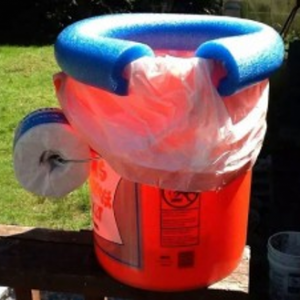
A 5-gallon bucket with a liner can serve as a toilet. Photo credit: Annette Lanham
- If you might be unable to flush the toilet during/after the storm, place a heavy-duty contractor trash bag in the toilet bowl to hold waste. Tie with a plastic tie and dispose of when full or as needed. Another option is to place the bag in a five-gallon plastic bucket. For added comfort, slit a foam pool noodle on one side and slip over the bucket edge for a “seat”; cut to fit. You can have two buckets – one for liquid waste and the other for solids.
- Before the storm arrives, wash dishes, catch up on laundry, clean the kitchen and bathrooms, and empty wastebaskets. This reduces clutter and promotes a clean environment in which to ride out the storm. It also reduces extra work and stress after the storm when water and electricity may be limited or unavailable.
For additional preparation tips, visit Homeowner’s Handbook to Prepare for Natural Disasters
Sources:
Ready.gov
DisasterSafety.org

by Judy Corbus | Jul 10, 2021

Stock up on canned fruits, vegetables, meats, and heat-and-eat soups for your hurricane food supply kit. Photo source: UF/IFAS Photo by Tyler Jones.
Now that we are officially in Hurricane Season (June1-November 30) and named storms are paying a call to the Sunshine State, it’s time to make sure we are prepared.
At the top of the list is planning meals for you and your family. Many people grab snack-type foods, such as crackers, cookies, and chips, or whatever is available on store shelves when the storm is approaching without having a meal plan in mind. Use MyPlate as a guide to plan meals to include fruits, vegetables, whole grains, protein, and dairy products. Foods from each food group provide important vitamins, minerals, and other nutrients to properly fuel your body so you are better equipped to deal with the challenges and stresses that accompany hurricanes and other disasters.
Plan a two-week supply of nonperishable or canned food and juices that require little or no cooking and no refrigeration. Include healthy snacks and any special foods for infants, senior adults, or persons with specific dietary needs. Select foods your family likes and will eat. Plan meals and shop early before a storm is on the horizon so you have a greater food selection and can take advantage of sales to stock up at a reduced cost. Keep planned written menus that have worked well for you and your family inside your hurricane food supply kit in a re-sealable plastic bag.
Brenda Marty-Jimenez, Family and Consumer Sciences Agent with UF/IFAS Extension Broward County, offers the following menu suggestions:
Breakfast Ideas
Apple juice • ready-to-eat cereal • small boxes of raisins • breakfast bars with fruit • shelf-stable skim milk • tea or instant coffee • water
Orange juice • hot cereal/instant oatmeal • banana • muffin • shelf-stable skim milk • tea or instant coffee • water
Grape juice •ready-to-eat cereal • canned peaches • yogurt • bread with jam or jelly • shelf-stable skim milk • tea or instant coffee • water
Lunch Options
Chunky beef soup (ready-to-eat style that only needs heating) • crackers • carrot and celery sticks • nuts • fruit cups packed in water • vanilla wafers • shelf-stable skim milk • tea or instant coffee • water
Canned cream soup (ready-to-eat style that only needs heating) • tuna sandwich on whole-wheat bread • tomato slices • unsweetened applesauce • cookies • shelf-stable skim milk • tea or instant coffee • water
Canned chili with beans (ready-to-eat style that only needs heating) • dinner rolls with margarine or butter • broccoli florets • canned fruit • animal crackers • shelf-stable skim milk • tea or instant coffee • water
Dinner Suggestions
Canned meat or cheese ravioli • three-bean salad (canned) • fresh yellow apples • bread with margarine or butter • fat-free pudding cup • shelf-stable skim milk • tea or instant coffee • water
Egg-salad sandwich on whole-wheat bread • canned green beans • canned fruit • fat-free pudding cup • shelf-stable skim milk • tea or instant coffee • water
Mac and cheese • canned vegetable • fresh pears • dinner rolls with margarine or butter • cookies • shelf-stable skim milk • tea or instant coffee • water
Remember the four key food safety principles: Cook, Clean, Chill, and Separate.
- Use a food thermometer to check the internal temperature of cooked foods.
- Wash hands for 20 seconds with soap and water. Sanitize food preparation and cooking surfaces regularly.
- Put leftovers in sealed bags or shallow containers and pack on ice or store in the refrigerator if it is running on a generator. Dispose of food that has been at room temperature for more than two hours (one hour if the temperature is 90oF or above) or has an off-odor, color, or texture.
- Toss out food that has come in contact with contaminated flood water. Do not eat foods from dented, swollen, or corroded cans, even though the food may appear safe to eat.
For more hurricane meal planning ideas and tips, visit: http://blogs.ifas.ufl.edu/browardco/2020/06/01/hurricane-preparedness-meal-and-menu-planning/










